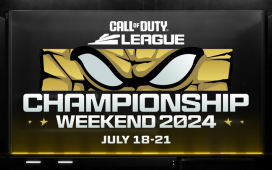Mentioned in this article
Swedish start-up WeHype has developed a self-serve platform that connects brands with gaming influencers. Launched in 2016, the tech company specializes in live branded content and marketing solutions for events, online, and mobile.
Magnus Leppäniemi, former sales director for brand partnerships in North America for DreamHack, has joined WeHype as global sales director. Leppäniemi, along with WeHype co-founder and CEO Robin Åström spoke with The Esports Observer to discuss the start-up’s role in the world of esports.
“We want to be the number one player destination for advertisers to be able to reach gamers on a global scale through influencers,” Åström explained, noting that WeHype focuses on influencers who stream gameplay for entertainment, as opposed to competition.
The company provides infrastructure to marketers and influencers through its self-serve platform which, according to the website, cuts campaign launch time “up to 95%.” On the marketing side, Åström says the company provides knowledge to both endemic and non-endemic brands to help communicate with gamers in “the most effective way.”

Åström reached out to Leppäniemi in January of this year and the dialogue turned into a job offer. Leppäniemi followed the start-up’s progress since its official launch in 2018 and was impressed with what it had accomplished in a short amount of time.
“The thing that tickled me to make the move [to WeHype] was coming in with the network and the knowledge that I have and building the sales department from scratch,” said Leppäniemi.
Leppäniemi noted similarities between working for WeHype and his journey with DreamHack. When he joined DreamHack in 2013, he says, it employed 13 people and now there are around 80. Leppäniemi isn’t daunted by the idea of “starting over,” but refers to the challenge as an interesting phase to face head-on.
The biggest difference between Leppäniemi’s previous role and the current one is brand recognition.

“When you say ‘DreamHack,’ everyone knows what that is. At WeHype, we have to explain a bit more about what we do and what the advantages are working with us,” he said. “That will change, however as we get working and the marketing department grows.”
Having worked for over five years at DreamHack, Leppäniemi has first-hand experience observing what hurdles exist that prevent major brands from entering the space.
“Data and information is [a] challenge,” he noted. “That’s something we can build to get the real brands in there like the McDonald’s and big FMCG brands like P&G or Unilever because they want to know what they’re buying. The whole business needs relevant numbers to compare events.
“What Nielsen is doing with the Overwatch League is a big step to bringing in non-endemic customers into the space,” he added.

Another challenge Leppäniemi observed was a lack of knowledge regarding the esports industry.
“It’s important to have knowledge of what’s going on [in esports] and also [realize that] esports isn’t just Counter-Strike,” he said, noting that brands with a policy against “violent” games can also consider titles like Rocket League or Hearthstone.
Each game comes with its own unique audience, Leppäniemi said, which brands need to consider before launching an activation.
“It’s like saying ‘we’re going to invest in sports;’ is it football, hockey, soccer, etc.? You need to tailor activations to who you’re talking to,” he added.

Åström notes that identifying a streamer’s audience is a vital part of any influencer marketing strategy.
“Before every activation, we look at what games have been streamed previously and viewership numbers to be able to predict if a new game or brand promotion is a good fit,” said Åström, using Tyler “Ninja” Blevins as an example.
“Someone like Ninja is very Fortnite heavy, so switching to another game would definitely see a drop in viewership numbers and engagement,” he added, pointing out that WeHype has been tracking data for two and a half years, allowing the company to accurately predict how introducing a new game would impact streamer engagement.
Depending on the intended result, brands shouldn’t get too focused on the most popular streamers alone, Åström warns.
“Looking at the actual numbers, the most value can be found in low- and mid-tier influencers and streamers,” Åström observed. “They have a more unique and personal approach to their viewers which also potentially drives better engagement and conversions for brands.”
He equates partnerships with large-scale influencers such as Ninja to “rings on the water” in that brands can obtain “pure brand awareness” but not much in the way of conversions. For that reason, he says, WeHype prefers to work with smaller streamers.
The WeHype platform aims to solve a dilemma that many brands face when approaching such an influencer marketing campaign—who has time to manage hundreds of streamers at once?
“[Our platform allows] us to work with a bigger volume of small and mid-size communities and streamers,” said Åström.

A trend has emerged in which brands partner with non-endemic celebrities for gaming-related marketing campaigns. While appropriate for endemic brands, Åström warns that this strategy isn’t for everyone.
“For non-endemic brands that want to build credibility, it’s not the best idea to sponsor or work with someone coming from outside the gaming community such as an NFL player,” he said. “If you want to build your credibility in the gaming world, then you should focus on certain types of communities and streamers instead.”
For the moment, Twitch and YouTube are the strongest activation platforms, Leppäniemi said, although they are keeping an eye on Mixer.
“Hopefully with the moves that Mixer is doing with Ninja trying to build their base of streamers and influencers, that Microsoft has a strong plan,” said Leppäniemi. “I think when they launch the next generation consoles they’ll actually be making a lot of content. This is good—influencers and tournament organizers need that competitive edge. We can’t have just one platform owning it all.”
This interview was conducted by Trent Murray.














